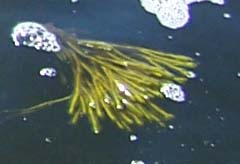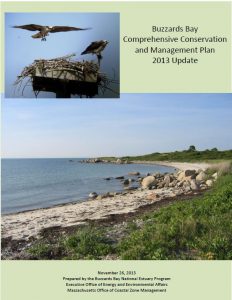2013 CCMP, Action Plan 11:
Managing Invasive and Nuisance Species
About the new Buzzards Bay CCMP Action Plans
The Buzzards Bay Comprehensive Conservation and Management Plan (CCMP) was updated in November 2013 to reflect the great progress achieved since the original CCMP was finalized. You can download the entire document (buzzards-bay-ccmp-2013-update.pdf) or just this action plan Managing Invasive and Nuisance Species.
Managing Invasive and Nuisance Species
Problem
Aquatic and terrestrial nuisance and invasive species represent a threat to endemic natural ecosystems of Buzzards Bay and its surrounding watershed. Once invasive species become established in an ecosystem, they are virtually impossible to eliminate. Therefore, management emphasis must be placed on regulatory controls and increased public awareness to prevent new introductions. Monitoring existing and identifying new invasives is an important tool in this effort by potentially helping elucidate transport pathways, and by identifying new introductions at an early stage where there may be a slight potential to eradicate them.
Goals
Goal 11.1. Minimize the potential introduction of new invasive and nuisance species to Buzzards Bay and its surrounding watershed.
Goal 11.2. Reduce the extent and limit the spread of existing invasive and nuisance species that are degrading habitats of Buzzards Bay and its surrounding watershed.
Objectives

The green algae Codium fragile, commonly known as Green Fleece, is an introduced species that appeared in Buzzards Bay in the 1960s.
Objective 11.1. Adopt and enforce laws, regulations, and policies that will reduce the potential spread of invasive species.
Objective 11.2. Educate the public, farmers, nursery owners, fisherman, pet storeowners, shipping industry, and other relevant sectors about individual actions that can be taken to reduce the threat of introducing invasive and nuisance species to the environment.
Objective 11.3. Fund and promote actions and studies to control and reduce existing populations of invasive and nuisance species.
Objective 11.4. Monitor existing and new invasives in order to help discern introduction pathways and to identify species in early stages of introduction where there may be a slight potential for containment.
Approaches
For the most part, once an invasive species has entered a region, little can be done to reverse its presence or control its population. Therefore, management action should focus on preventing new introductions, and to monitor existing conditions. Monitoring for the presence of introduced species is important so that scientists and managers can better discern whether shifts in naturally occurring species are likely the result of human perturbations, like pollution, or are possibly caused by predation or competition with introduced species. Monitoring can also document trends and help discern pathways of inva-sive migrations. This information can help inform policy decisions and regulatory formulation.
Posting maps and information about introduced species and enabling easy online reporting by residents can help achieve the objectives of this action plan. CZM and the MassBays Program have already established websites for information on marine aquatic invasives in Massachusetts, and residents and municipal officials of Buzzards Bay should be encouraged to use the available online tracking and reporting forms.
The most effective approach to avoiding new introductions is through education and the enforcement of existing laws, regulations, and through adoption and enforcement of new preventative measures. These efforts will not succeed unless there is increased awareness and acceptance of the problem by the public, businesses, and educational institutions. In this way, all these groups can take voluntary measures or implement best management practices to minimize the threat of introducing non-natives into the environment.
Because pathways, impacts, and the extent of introduced species has not been well documented or understood, monitoring and research is needed not only to evaluate success of control measures, but is a fundamental need to better define the extent of the problem and the viability of proposed solutions.
Costs and Financing
Better tracking, mapping, and monitoring of key invasive aquatic and terrestrial species could be achieved with annual expenditures in the tens of thousands of dollars utilizing resident volunteers, online reporting with oversight and review by wildlife scientists and biologists. More comprehensive mapping efforts, together with research into the pathways and impacts of invasives, can cost millions of dollars. Measures to control species through eradication efforts can cost thou-sands to hundreds of thousands of dollars per site. There is a cost to government to enforce compliance with new regulations in terms of staff, and compliance of industry with these regulations can range from negligible (e.g. species import bans) to substantial (e.g. ballast water treatment).
Measuring Success
Tracking the extent and abundance of introduced species, together with documentation of the rate of new species introductions will be the measure of the success of this action plan, as well as programmatic measures like the adoption of new regulations.
